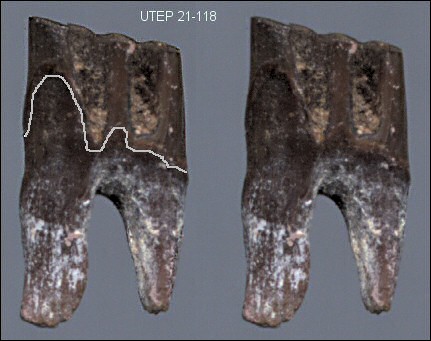

Sometimes the strangest things can be used to tell animals apart. Of course, if every little furry thing is called a mouse or a rat, you don't need real skills in identification. However, biologists know that there are many different kinds of rodents, and that sometimes its very difficult to tell them apart. And if you're working with fossils represented solely by bones and teeth, it becomes doubly hard.
Six different species of fossil packrats have been identified from ice
age deposits in the Chihuahuan Desert. Luckily, none is extinct, so we have the living
ones for comparison. One feature, apparently first recognized in fossils, is the
lateral dentine tract. This is merely a place on the first lower grinding tooth of
these rats where enamel is missing, allowing the underlying dentine to show through. In
some species, this goes well up the side of the tooth; in others, this tract is low,
and in yet other species, virtually absent. Thus something so minor that modern
biologists didn't even notice it became a vital tool for the paleontologist.

Contributor: Arthur H. Harris, Laboratory for Environmental Biology, Centennial Museum, University of Texas at El Paso.
Desert Diary is a joint production of the Centennial Museum and KTEP National Public Radio at the University of Texas at El Paso.

Left lower first molar of fossil Neotoma mexicana from the Khulo Site (UTEP 21-118), Doña Ana Co., New Mexico. The copy on the left has the lower border of the enamel demarcated by the gray line. The higher portion in the left segment (anterior) of the tooth is the anterior lateral dentine tract. Scanned image by A.H. Harris.
Harris, A. H. 1984. Neotoma in the late Pleistocene of New Mexico and Chihuahua. Pp. 164-178, in Contributions in Quaternary vertebrate paleontology: a volume in memorial to John E. Guilday (H. H. Genoways and M. R. Dawson, eds.). Carnegie Mus. Nat. Hist., Spec. Publ., 8:1-538.